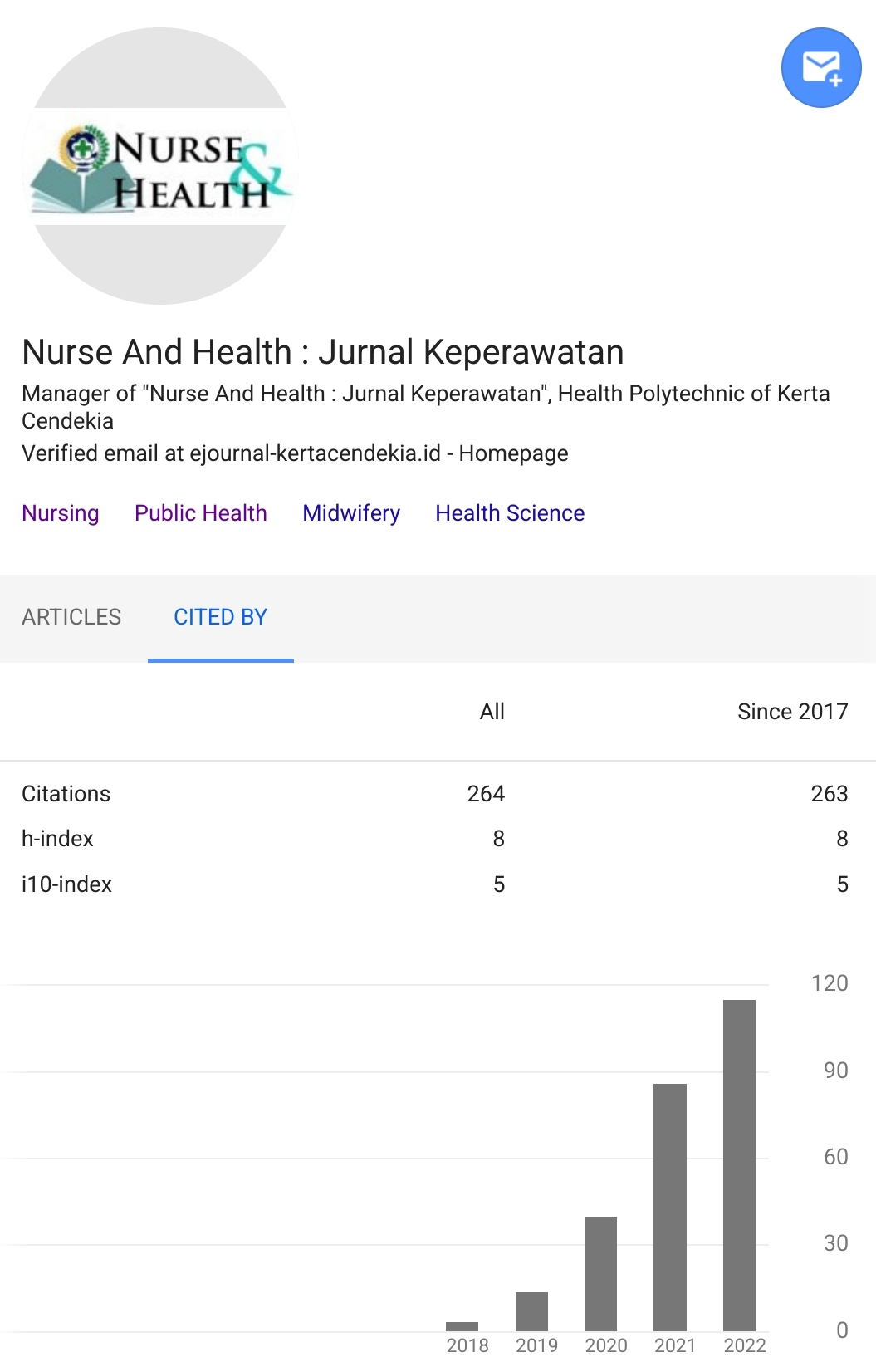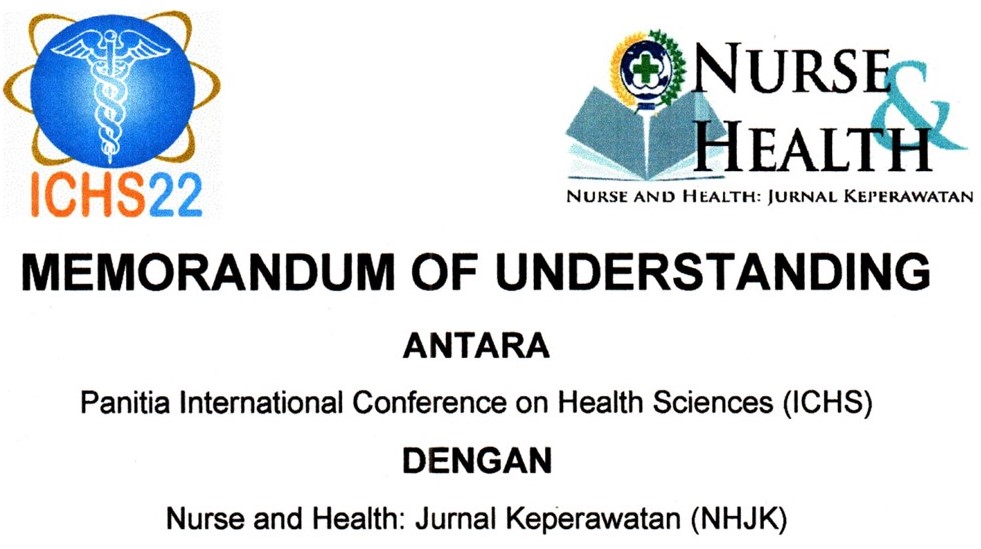THE EFFECT OF INFRARED RAY AND COUNSELING ON DIABETIC FOOT ULCER HEALING PROCESS
Abstract
Background: Diabetic foot ulcer is one of the chronic complications of diabetes mellitus caused by neuropathy, angiopathy and decreased endurance. The risk of amputation in patient with diabetes mellitus fifteen times greater compared to non-diabetic. Various efforts on diabetic foot wound care have been carried out but the results are still far from satisfactory. Until now, infrared and counseling effect on wound healing in diabetic foot cannot be explained.Objective: The purpose of this study was to examine the effect of infrared ray and counseling on diabetic foot ulcer healing process.Method: The research design was quasi-experimental design with posttest control group design, the population in this study were patients with grade 3 diabetic foot wounds, blood sugar 100-200 g/ dl, BMI 18.5 to 24.9, aged 35-55 years. Large sample in this study as many as 20 were divided into two groups, the control random sampling. The collection of data for the dependent variable using the observation sheet after the tenth day of treatment, which consists of the rate of growth of granulation, ankle brachial index and capillary refill time. Furthermore, the data were processed using non-parametric statistical significance level < 0.05.Result: The results showed that the infrared and counseling effect on the growth of granulation with a significance level (p = 0.0003), infrared and counseling influence ankle brachial index (p = 0.024), infrared and counseling effect on capillary and counseling effect on capillary refill time (p = 0.024).Conclusion: It can be concluded from this study that applying infrared and counseling has any impact on healing in diabetic foot ulcer, on the growth of granulation and improved blood in diabetic foot ulcers. Key words: Infrared Ray, Counseling, Foot Ulcer Healing.Downloads
References
Alligood, M. R. (2017). Nursing Theorists and Their Work-E-Book. Elsevier Health Sciences.
American Diabetes Association. (2013). Diagnosis and classification of diabetes mellitus. Diabetes care, 36(Supplement 1), S67-S74.
Anderson, W. A. D., & Scotti, T. M. (1980). Synopsis of pathology. London: CV Mosby.
Black, J. M., & Jacob’s, E. M. (2009). Medical Surgical Nursing Clinical Management for Continuity of Care 8th edition. India: Elsevier.
Boggs, D. R., & Winkelstein, A. (1983). White Cell Manual 4th Edition. Philadelphia: F. A. Davis Co. P.34.
Brunner and Suddarth. (2013). Buku Ajar Keperawatan Medikal Bedah Edisi 8 Volume 2. Jakarta: EGC.
Corwin, J. E. (2009). Patophysiologi, Edisi 3. Jakarta: EGC. P. 156-158.
Dealey, C. (2012). The Care of Wound A Guide For Nurses, 4th edition. BlackWell Publishing Ltd. P.147.
Dhirgo, A. (2008). Wound Care. Retrieved from https://142118195dhirgoadjie.wordpress.com/wound-care-science/.
Gabriel, J. F. (2012). Fisika Kedokteran. Jakarta: EGC.
Gospodarowicz, D. (1983). Growth factors and their action in vivo and in vitro. The Journal of pathology, 141(3), 201-233. DOI: 10.1002/path.1711410304.
Gunawan, Y. (2001). Pengantar Bimbingan dan Konseling Buku Panduan Mahasiswa. Jakarta: Prenhallindo.
Haimovici, H. (1994). Vasculer Surgery: Principles and Techniques 4th Edition. New York: Mc.Graw Hill Book Company.
Heyder, A. F. (1998). Peran Bedah Vaskular Dalam Upaya Menyelamatkan Tungkai (Limb Salvage) Di Era Keterbatasan Dana Dan Sarana Kesehatan.
Hidayat, A. (2008). Pengantar Konsep Dasar Keperawatan, edisi 2. Jakarta: Salemba Medika.
Kivirikko, K. A. (1984). Heritable diseases of collagen. N Engl j Med, 311, 376-86.
Kozier, B. (1995). Fundamentals of Nursing, Concepts, process and Practice. California: Addison-Wesley Co.
Lasser, A. (1983). The mononuclear phagocytic system: a review. Human pathology, 14(2), 108-126.
Makhdoom, A., Khan, M. S., Lagahari, M. A., Rahopoto, M. Q., Tahir, S. M., & Siddiqui, K. A. (2009). Management of diabetic foot by natural honey. J Ayub Med Coll Abbottabad, 21(1), 103-105.
Marvin, E. L. (1977). The Diabetic Foot. 2nd edition. Saint Louis: Mosby Company. P. 1-46.
Misnadiarly. (2006). Diabetes Mellites: Gangren, ulcer, infeksi. Mengenal Gejala, Menanggulangi & Mencegah Komplikasi. 1st Edition. Jakarta: Pustaka Populer Obor.
Morison, M. J. (2004). Manajemen Luka Seri Pedoman Praktis. Jakarta: EGC.
Notoadmodjo, Soekidjo. (2002). Metode Penelitian Kesehatan. Jakarta: Mangun Cipta.
Nursalam. (2016). Metodologi Penelitian Ilmu Keperawatan: Pendekatan Praktis Edisi 4. Jakarta: Salemba Medika.
Pemayun, T.G.D. (2002). Gambaran Makro dan Mikroangiopati Diabetik di Poliklinik Endokrin dalam Naskah Lengkap Konggres Persedia dan Perkeni. Semarang: Diponegoro University. P 87-97.
Peplow, P. V., Chung, T. Y., & Baxter, G. D. (2010). Laser photobiomodulation of wound healing: a review of experimental studies in mouse and rat animal models. Photomedicine and laser surgery, 28(3), 291-325.Potter, P. A., & Perry, A. G. (2011). Fundamental Keperawatan. buku 2 edisi 7. Jakarta: Salemba Medika.
Price, S.A., & Lorraine Mc. (1982). Pathophysiology: Clinical Concepts of Disease Processes 2nd Edition. New York: Mc. Graw Hill. Inc. P 23-26.
Pusat Diabetes dan Lipid RSUP Nasional Dr. Cipto Mangunkusumo Fakultas Kedokteran Universitas Indonesia (2007). Penatalaksanaan Diabetes Millitus. Jakarta.
Rau, C. S., Yang, J. C. S., Jeng, S. F., Chen, Y. C., Lin, C. J., Wu, C. J., ... & Hsieh, C. H. (2011). Far‐Infrared Radiation Promotes Angiogenesis in Human Microvascular Endothelial Cells via Extracellular Signal‐Regulated Kinase Activation. Photochemistry and photobiology, 87(2), 441-446.
Robbins, S. L. (1979). Phatologic Basis of Disease. Ed.2nd. Philadelpia London Toronto: W.B. Saunders Company. P 90-95.
Sagarnaik, L. C. (2009). Retrieved from https://www.scrib.com/doc/7112253/infrared_radiation
Schindl, A., Schindl, M., Schön, H., Knobler, R., Havelec, L., & Schindl, L. (1998). Low-intensity laser irradiation improves skin circulation in patients with diabetic microangiopathy. Diabetes care, 21(4), 580-584.
Schindl, A., Heinze, G., Schindl, M., Pernerstorfer-Schön, H., & Schindl, L. (2002). Systemic effects of low-intensity laser irradiation on skin microcirculation in patients with diabetic microangiopathy. Microvascular research, 64(2), 240-246.
Tamsuri, Anas. (2007). Konseling dalam Keperawatan, Jakarta: EGC.
Tandra, Hans (2007), Segala Sesuatu yang harus Anda ketahui tentang Diabetes. Panduan Lengkap mengenal dan Mengatasi Diabetes dengan Cepat dan Mudah, Jakarta: Gramedia Pustaka Utama.
Taylor, Carol. (2010). Fundamentals of Nursing, The Arts and Science of Nursing Care, 7th Edition. Philadelphia : J.B. Lippincott. P: 387.
To, W. S., & Midwood, K. S. (2011). Plasma and cellular fibronectin: distinct and independent functions during tissue repair. Fibrogenesis & tissue repair, 4(1), 21. DOI https://doi.org/10.1186/1755-1536-4-21.
Toyokawa, H., Matsui, Y., Uhara, J., Tsuchiya, H., Teshima, S., Nakanishi, H., ... & Kamiyama, Y. (2003). Promotive effects of far-infrared ray on full-thickness skin wound healing in rats. Experimental biology and medicine, 228(6), 724-729.
Wagner, B. M. (1985). Wound healing revisited: fibronectin and company. Human pathology, 16(11), 1081.
Walter J.B. (1987). General Pathology. 6th Edition. Edinburgh London Melbuorne and New York: Churchill livingstone. P.97.
Wasis. (2008). Pedoman Riset Praktis untuk Profesi Perawat. Jakarta: EGC.
Waspadji, S. (1997). Kaki Diabetik Kaitannya dengan Neuropati Diabetik dalam Makalah Kaki Diabetik Patogenesis dan Penatalaksanaan. Semarang: Univ. Diponegoro.
Werb, Z. (1984). Macrophages insites D.P et al (eds): Basic & Clinical Immunology 5th edition. Los Altos: Lange Medical Publications. P.104.
Yu, S. Y., Chiu, J. H., Yang, S. D., Hsu, Y. C., Lui, W. Y., & Wu, C. W. (2006). Biological effect of far‐infrared therapy on increasing skin microcirculation in rats. Photodermatology, photoimmunology & photomedicine, 22(2), 78-86.
Yusuf, Sinaga. (2009). Penyembuhan Luka (Wound healing). Retrieved from https://yusufsinaga.wordpress.com/2009/04/19/penyembuhan-luka/ on November 20th, 2009.
Authors who publish with Nurse and Health: Jurnal Keperawatan agree to the following terms:
- Authors retain copyright licensed under a Creative Commons Attribution-NonCommercial 4.0 (CC BY-NC 4.0), which allows others to remix, tweak, and build upon the authors' work non-commercially, and although the others' new works must also acknowledge the authors and be non-commercial, they don't have to license their derivative works on the same terms.
- Authors are permitted and encouraged to post their work online (e.g., in institutional repositories or on their website) prior to and during the submission process, as it can lead to productive exchanges, as well as earlier and greater citation of published work (See The Effect of Open Access). Authors can archive pre-print and post-print or publisher's version/PDF.








_resize1.jpg)















